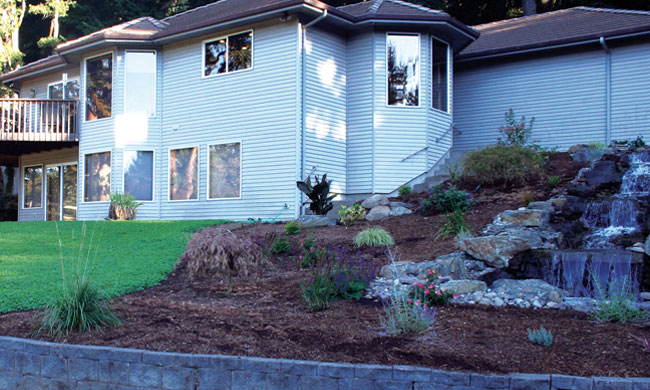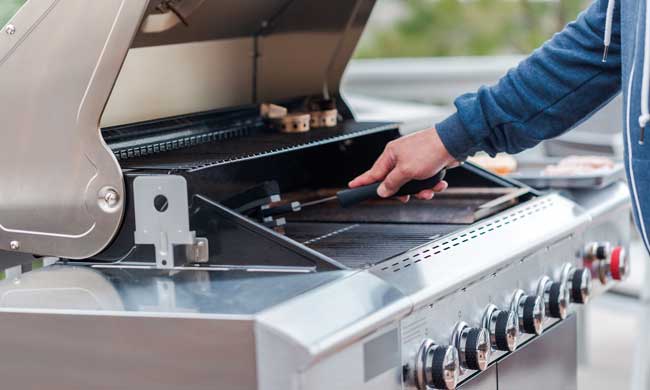Live Better
The mini, but mighty shamrock-shaped solution for lawn renovation

Miniclover is drought-tolerant, simple,stunning and sustainable with low-to-no maintenance
(OutsidePride.com) That lush, green lawn most strive for is struggling to survive as our climate experiences “weather whiplash,” meaning abrupt swings in weather conditions from one extreme to another. Last season, drought conditions were so dire in California billboards shouted, “Brown is the New Green.” This season, despite early, extreme flooding in California, evidence suggests the length and depth of droughts will increase in upcoming years, becoming more frequent and severe.
Outdoor water usage is still astronomical, synthetic chemical use is ever-present and fuel-guzzling lawn blowers and mowers sing all summer. Traditional lawn maintenance is expensive, unnatural, untenable and increases greenhouse gasses, wastes water, pollutes ecosystems and reduces biodiversity.
Average American families use 320 gallons of water daily, about 30% outdoors, with more than half devoted to watering lawns and gardens, according to the EPA. Nationwide, landscape irrigation is estimated at almost one-third of all residential water usage, totaling nearly 9 billion gallons daily.
Gas-powered lawn mowers spew pollutants that can cause planet-warming gases, contributing to climate crisis and drought. According to the EPA, gas-powered lawn equipment releases more than 22 million tons of CO2 emissions and estimates over 17 million gallons of gasoline are spilled refueling lawn equipment; that’s more than all oil spilled by Exxon Valdez.
There are many issues causing harm to environmental health, from the ridiculous, like billionaires taking 17-minute flights in private jets, producing 2 tons of CO2 emissions, to everyday lawn care wasting staggering amounts of water for aesthetics whilepolluting the environment through run-off and toxic emissions.
Cash rebates, up to $5,000, are being offered to some for the removal of grass lawns. To get the rebate, other water-efficient options must be put in place. It’s time to take a page from the past; sowing clover seed can create a great-looking, water-efficient, sustainable lawn. Decades ago, clover was standard in lawn seed mixes. Then agricultural chemical companies created herbicides to rid lawns of broadleaf plants, killing everything but grass, clovers included, branding them weeds.
“Today, clover is making a comeback,” said Troy Hake, president and owner of Outsidepride.com, offering drought-tolerant grasses, clovers, wildflower seeds and more. “Tik Tok’s #cloverlawn has over 65 million views, evidencing it’s time for sustainable options, like adding ‘miniclover’ or replacing lawns with it. Miniclover (trifolium repens), is one-third to half the size of white Dutch clover, only grows 4-6 inches and produces a thick, carpet-like look that blends well with turf. Less expensive than grass seed, it’s a natural solution for self-sustaining, low-maintenance lawns that look beautiful and help eliminate the need for fertilizers, herbicides, pesticides and weekly mowing. It’s healthier for people, pets, soil and waterways. You can’t go wrong with it.”
There’s nothing you can do about those 17-minute private jet flights. However, anyone with a lawn can add-in miniclover and redefine what sustainable lawns and responsible lawn care looks like. Sales of miniclover rose dramatically last season, surely an indicator that this lawn renovation trend was well-received and continues to grow.
Benefits:
Nitrogen fixer. Miniclover takes nitrogen from the air and “fixes” it in soil, eliminating the need to apply nitrogen, keeping lawns green and growing while adding natural nitrogen to surrounding soil.
Drought tolerant. Miniclover is drought-tolerant and canstay green all summer with minimal watering.
Deters bugs. Grubs that feed on grass roots will not eat miniclover, and adult beetles and bugs are deterred from laying eggs in it.
Crowds out weeds. Miniclover is evenly dispersed via stolons (stems grow horizontally along the ground), crowding out weeds, preventing new weeds and controlling erosion.
Low-to-no maintenance. You can mow miniclover – the more it’s cut, the smaller the leaf size – or let it grow. Miniclover only blooms once in summer, providing bees with nectar, or mowing will prevent blooming.
Thrives in sun to partial shade. Miniclover does well in partial shade that receives some direct sunshine daily.
Stands up to soil and subsoil compaction.
Immune to “dog patches.” Dog urine discolors lawns, but miniclover stays green and lush.
Feels soft and springy on bare feet and looks like ordered whimsy.
So… what’s not to like?
For other drought-tolerant options, visit Outsidepride.com.
Photos courtesy of OutsidePride.com
SOURCE:
OutsidePride.com
Live Better
5 tips for new pet owners

(Family Features) Welcoming a new pet is exciting, but preparation is needed to provide a loving home and enjoy the unconditional love.
Prepare your furry friend for a new home with these essential tips for first-time pet owners.
Choose the Right Pet for Your Lifestyle
Consider your living situation, work schedule and personal preferences. Research different breeds to find the one that matches your activity level, living space and family dynamics. Also consider any allergies or sensitivities you or your family may have as some pets may trigger allergies or asthma symptoms.
Set Up Your Home
Before bringing your new pet home, create a safe and comfortable environment. Start by pet-proofing your home, removing any hazardous substances and securing loose wires or cords. Make sure to store cleaning supplies, medications and toxic plants out of reach. Provide a designated space that includes a cozy bed or crate, food and water bowls and toys.
Create a Routine
Establish a consistent schedule for feeding, exercise and bathroom breaks. Determine the appropriate amount and frequency of meals for your pet’s age, size and breed. Spend quality time with your pet daily, providing attention, affection and mental stimulation.
Budget for Your Pet’s Needs
Owning a pet comes with financial responsibilities. Consider the costs of food, grooming, veterinary care, vaccinations and preventive medications. Additionally, factor in the cost of toys, bedding, litter and other supplies.
Find a Reliable Veterinarian
Regular check-ups and open communication with a local veterinarian can help detect any potential health issues early and ensure your pet receives the best possible care. Ask friends, family or neighbors with pets for provider recommendations and read reviews. Visit potential veterinarians’ offices to meet the staffs, tour the facilities and ask any questions you may have.
Find more tips for welcoming a furry friend into your home at eLivingtoday.com .
Photo courtesy of Unsplash
Watch video to find out how!
SOURCE:
eLivingToday.com
Live Better
6 steps to spring into lawn, garden care

(Family Features) If cooler weather has you longing for sunny days outdoors, take heart. Once spring rolls around, you can prepare your yard for months of warm-weather enjoyment with these tips.
Watch video to find out how!

- Clear the Yard
Remove any leaves, rocks or sticks that may have accumulated then cut the grass as short as you can.

- Dethatch
Use a thatching rake to remove dead roots and grass.

- Treat Weeds
Apply herbicide to treat weed-infested areas. Allow the weed killer to work for about a week then rake to remove dead weeds.

- Add Seed and Fertilizer
Depending on your lawn’s needs, overseed or spot seed to fill in thin spots. Use a grass variety that matches your climate for best results. Select and apply fertilizer consistent with your grass type then water thoroughly.

- Clear Garden Beds of Debris
Remove leaves and other matter that piled up in your garden during the cooler months. Gently turn the soil and work in fresh fertilizer.

- Start Planting
Early spring is the time to divide perennials and plant hardier vegetables, such as onions and potatoes. You can also start indoor seeds, if necessary, and move plants outdoors when the weather permits.
Getting some of your lawn and garden care underway now can make those warmer, sunny days feel closer in no time. Find more seasonal tips for prepping your yard at eLivingtoday.com.
SOURCE:
eLivingToday
Live Better
A how-to guide for deep cleaning your grill

(Family Features) A clean grill can enhance the flavor of your food, making regular grill maintenance an essential part of your outdoor cooking routine.
Grills, especially those exposed to the elements, can accumulate dirt, rust and food residue that can affect performance and safety. Plus, residual char and grease can impart unwanted flavors and even lead to flare-ups.
Once you’ve gathered the right tools – a sturdy grill brush with stainless steel bristles, a scraper, a bucket of soapy water, microfiber cloths and grill cleaner or degreaser – consult this step-by-step guide to keep your grill in pristine condition, ensuring delicious meals every time.
- Preheat the grill for 15 minutes to loosen any stuck-on residue then turn it off and let it cool slightly.
- Ensure the gas supply is turned off before cleaning.
- Remove the grates and scrub them thoroughly with a grill brush and warm, soapy water. Rinse and let dry.
- Clean burners by wiping them with a damp cloth.
- Scrape the inside of the grill to remove any debris and use a vacuum to collect loose dirt and ash.
- Wipe down the exterior of the grill with a microfiber cloth and grill cleaner.
- Reassemble the grill once all parts are dry and give it a final wipe down.
In between deep cleanings, remember to clean your grill grates immediately after cooking while they are still warm to remove food particles and grease. Find more tips for the grill and beyond at eLivingtoday.com.
Photo courtesy of Shutterstock
SOURCE:
eLivingtoday.com
-

 NEWS2 years ago
NEWS2 years ago2 hurt, 1 jailed after shooting incident north of Nocona
-

 NEWS1 year ago
NEWS1 year agoSuspect indicted, jailed in Tia Hutson murder
-

 NEWS2 years ago
NEWS2 years agoSO investigating possible murder/suicide
-

 NEWS2 years ago
NEWS2 years agoWreck takes the life of BHS teen, 16
-

 NEWS2 years ago
NEWS2 years agoMurder unsolved – 1 year later Tia Hutson’s family angry, frustrated with no arrest
-

 NEWS2 years ago
NEWS2 years agoSheriff’s office called out to infant’s death
-

 NEWS2 years ago
NEWS2 years agoBowie Police face three-hour standoff after possible domestic fight
-

 NEWS2 years ago
NEWS2 years agoDriver stopped by a man running into the street, robbed at knifepoint







